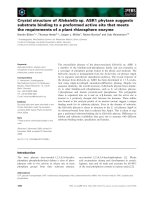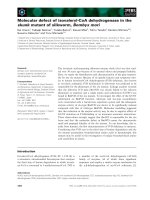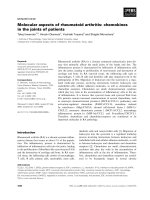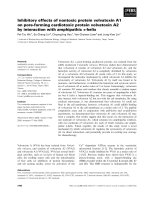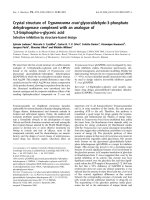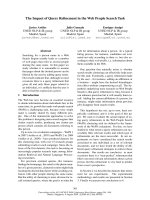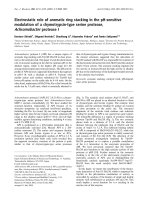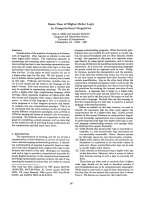Báo cáo khoa học: Fast set-up of doxycycline-inducible protein expression in human cell lines with a single plasmid based on Epstein– Barr virus replication and the simple tetracycline repressor ppt
Bạn đang xem bản rút gọn của tài liệu. Xem và tải ngay bản đầy đủ của tài liệu tại đây (639.49 KB, 8 trang )
Fast set-up of doxycycline-inducible protein expression in
human cell lines with a single plasmid based on Epstein–
Barr virus replication and the simple tetracycline repressor
Markus Bach
1
, Silke Grigat
1
, Barbara Pawlik
1
, Christian Fork
1
, Olaf Utermo
¨
hlen
2
, Sonia Pal
1
,
David Banczyk
1
, Andreas Lazar
1
, Edgar Scho
¨
mig
1,3
and Dirk Gru
¨
ndemann
1,3
1 Department of Pharmacology, University of Cologne, Germany
2 Institute for Medical Microbiology, Immunology, and Hygiene, University of Cologne, Germany
3 Center for Molecular Medicine, University of Cologne (CMMC), Germany
The function of human proteins is commonly analyzed
by heterologous expression in cultured cell lines. Regu-
lated expression, i.e. a system to switch on expression
on demand, has clear advantages over constitutive
expression. With constitutive expression, cells may die
during antibiotic selection because of toxic effects of
the expressed protein [1]. Also, for a close match of
backgrounds, it is better to compare two states of a
single cell line rather than two separately transfected
and selected cell lines.
Several widely used systems for regulated expression
in mammalian cell lines are based on the tetracycline
Keywords
doxycycline; Epstein–Barr virus;
polyadenylation; regulated protein
expression; tetracycline repressor
Correspondence
D. Gru
¨
ndemann, Department of
Pharmacology, University of Cologne,
Gleueler Straße 24, 50931 Cologne,
Germany
Fax: +49 221 478 5022
Tel: +49 221 478 7455
E-mail:
(Received 17 October 2006, revised
5 December 2006, accepted 5 December
2006)
doi:10.1111/j.1742-4658.2006.05623.x
We have developed a novel plasmid vector, pEBTetD, for full establish-
ment of doxycycline-inducible protein expression by just a single transfec-
tion. pEBTetD contains an Epstein–Barr virus origin of replication for
stable and efficient episomal propagation in human cell lines, a cassette for
continuous expression of the simple tetracycline repressor, and a cytomega-
lovirus-type 2 tetracycline operator (tetO2)-tetO2 promoter. As there is no
integration of vector into the genome, clonal isolation of transfected cells is
not necessary. Cells are thus ready for use 1 week after transfection; this
contrasts with 3–12 weeks for other systems. Adequate regulation of pro-
tein expression was accomplished by abrogation of mRNA polyadenyla-
tion. In northern analysis of seven cDNAs coding for transport proteins,
pools of transfected human embryonic kidney 293 cells showed on ⁄ off
mRNA ratios in the order of 100 : 1. Cell pools were also analyzed for
regulation of protein function. With two transport proteins of the plasma
membrane, the on ⁄ off activity ratios were 24 : 1 and 34 : 1, respectively.
With enhanced green fluorescent protein, a 23 : 1 ratio was observed based
on fluorescence intensity data from flow cytometry. The unique advantage
of our system rests on the unmodified tetracycline repressor, which is less
likely, by relocation upon binding of doxycycline, to cause cellular distur-
bances than chimera of tetracycline repressor and eukaryotic transactiva-
tion domains. Thus, in a comprehensive comparison of on- and off-states,
a steady cellular background is provided. Finally, in contrast to a system
based on Flp recombinase, the set-up of our system is inherently reliable.
Abbreviations
CMV, cytomegalovirus; EBV, Epstein–Barr virus; ETTh, ergothioneine transporter from human; GAPDH, glyceraldehyde-3-phosphate
dehydrogenase; eGFP, enhanced green fluorescent protein; MPP
+
, 1-methyl-4-phenylpyridinium; rtTA, reverse tetracycline-controlled
transcriptional activator; tetO2, type 2 tetracycline operator; TetR, tetracycline repressor; tTA, tetracycline-controlled transcriptional activator;
tTS, tetracycline-controlled transcriptional silencer.
FEBS Journal 274 (2007) 783–790 ª 2007 The Authors Journal compilation ª 2007 FEBS 783
repressor (TetR) [2,3]. Current systems require two or
three rounds of transfection of separate plasmids and
clonal isolation, which makes setting-up an inducible
cell line a protracted (at least 3 weeks if one buys cell
lines prepared for the final round, or 12 weeks if one
starts from scratch) and expensive procedure. In order
to avoid clonal selection in the final round of trans-
fection, the Flp-In
TM
-T-Rex
TM
system (Invitrogen,
Karlsruhe, Germany) may be used. Here, in the first
transfection, a Flp recombinase target site is introduced
randomly into the genome; tetR follows in the second
transfection. In the final transfection, Flp recombinase
from a cotransfected plasmid is used to integrate the
plasmid for protein expression into the target site. Since
the open reading frame for hygromycin resistance on the
expression plasmid lacks a start codon, random integra-
tion into the genome does not yield resistant cells. This
leads to a uniform pool of transfected cells; clonal selec-
tion is unnecessary. Unfortunately, despite intensive
scrutiny, we and others have experienced a high failure
rate (90% of all transfections) with this system, where
no clones at all were generated in the end, even with the
positive control plasmid supplied.
The major bottleneck in stable transfection of cells
arises from the low frequency of stable plasmid integ-
ration into genomic DNA. At best, only 0.001% of
cells generate clones. Expansion of the few survivors
takes weeks, particularly with selection and functional
testing of individual clones. In contrast, plasmids with
an Epstein–Barr virus (EBV) origin of replication oriP
in the presence of EBV-encoded EBNA-1 protein are
continuously propagated in 1% of initially transfect-
ed cells [4]. EBV plasmid replication has been demon-
strated for a large variety of human cell lines; primate
and canine cell lines may also be used [5]. It has been
extensively documented that the plasmids are main-
tained episomally (5–10 copies per cell, e.g. for 293
cells), i.e. they do not integrate into genomic DNA
[5–7]. Hence, it is expected that clone-specific effects of
the genetic neighbourhood (positional effects) on pro-
tein expression are avoided [8]. It thus becomes feasible
to work with transfected cell pools instead of single
cell clones. Altogether, it would save much time to
employ an EBV vector that carries all elements neces-
sary for doxycycline-regulated gene expression on a
single plasmid.
We have recently developed a substrate search strat-
egy for integral membrane transport proteins termed
‘LC-MS difference shading’ [9]. Our strategy is based
on comparative analysis of lysates of cells both with
and without transporter expression. The expression of
all other proteins in the two cell populations should
match as closely as possible. Thus, for us, a suitable
system for regulated gene expression must provide an
identical background.
EBV-derived single-plasmid systems for tetracycline-
regulated gene expression have been described previ-
ously; these are based on the TetR-VP16 fusion
proteins tetracycline-controlled transcriptional activa-
tor (tTA) [10] or reverse tetracycline-controlled tran-
scriptional activator (rtTA) [8]. A third system [11] is
based on concomitant expression of two fusion pro-
teins, i.e. rtTA2
S
-M2, which contains three tandem
repeat VP16 minimal activation domains, and tetra-
cycline-controlled transcriptional silencer (tTS)
KRAB
,
which contains the N-terminus of the KRAB repressor
domain of the mammalian Kox1 protein. However, it
is well known that transactivator domains, such as
VP16, interact with a variety of transcription factors
[12,13]. Indeed, analysis of expression levels in stably
transfected HeLa cells suggests that in high numbers,
even TetR fusion proteins based on VP16 minimal
activation domains are toxic [12]. Thus, relocation of
TetR fusion proteins upon binding of inducer can be
expected to cause secondary background differences.
Pronounced alteration of rtTA expression levels after
addition of inducer would promote further differences
[8]. Another single-plasmid EBV system based on regu-
lation by temperature shift (29 °C versus 37 °C) was
also expected to display disturbing background differ-
ences [14]. Instead we opted to utilize continuous
expression of the unmodified TetR. The original tetra-
cycline repressor simply binds to a tandem of the
type 2 tetracycline operator (tetO2) operator and thus
blocks transcription from the upstream cytomegalo-
virus (CMV) promoter [15]. Addition of tetracycline or
doxycycline to the culture medium turns on expression:
the inducer binds to the repressor, which then dissoci-
ates from the operator. From the lack of interaction of
the unmodified TetR with mammalian transcription
factors, a steady background can be expected. In addi-
tion, evidence from yeast suggests that the inducer
doxycycline itself has no significant effect on global
transcription levels [16]. Thus, it was our aim to
develop a single-plasmid EBV vector for doxycycline-
regulated gene expression based on the simple TetR.
Such a vector has not been reported before.
Results and Discussion
We have constructed plasmid pEBTet which links all
elements necessary for doxycycline-inducible expres-
sion with the EBV origin of replication (Fig. 1). The
orientation of elements in this vector appears to be
critical, since an otherwise identical plasmid with the
tetR cassette in reverse orientation yielded no viable
Fast set-up of inducible protein expression M. Bach et al.
784 FEBS Journal 274 (2007) 783–790 ª 2007 The Authors Journal compilation ª 2007 FEBS
cells after transfection and antibiotic selection (not
shown).
Initially we tried to partition all elements to two
plasmids in order to avoid a single large plasmid.
However, with the two-plasmid system, where both
plasmids contained oriP and a different selection mar-
ker, growth of transfected cells was unsteady, perhaps
because of oriP interference. Actually, our worries
over the relatively large pEBTet vector (11.5 kb) were
unfounded, as standard cloning procedures can be fol-
lowed.
With pEBTet, the phase of antibiotic selection and
cell expansion is much shorter than in other systems
outlined above. It takes only about a week after trans-
fection until it is possible to harvest a fully grown
culture flask (175 cm
2
). For all subsequent analysis,
pooled cells were used. With seven cDNAs coding for
transport proteins, northern blot analysis of 293 cells
transfected with the respective pEBTet plasmids consis-
tently revealed strong transcription in the on-state
(¼ 100%) and low background (1–2%, measured by
radioluminography) in the off-state (Fig. 2; Table 1).
We have observed comparable ratios (100 : 1) with the
Flp-In
TM
-T-Rex
TM
system. Thus, as far as regulation
of transcription is concerned, the pEBTet vector works
well: in the off-state, tetO2 elements are sufficiently
covered by TetR to block transcription almost com-
pletely.
Transporter expression in 293 cells was assayed
functionally by initial rates of uptake of substrates; ini-
tial rates of uptake are directly proportional to trans-
porter number. With the ergothioneine transporter
from human (ETTh; see Fig. 3A) and enhanced green
fluorescent protein (eGFP) chimeras of ETTh and of
ORCTL3h (not shown), the high signal-to-noise ratio
of the mRNA corresponded to a similar ratio for
transport function or eGFP fluorescence intensity.
However, with OCT1h (Fig. 3B) and OCT2h (not
shown) we obtained inadequate ratios; for our assays,
we aim for at least a 10 : 1 ratio. It was reasoned that
with some cDNAs, even the low mRNA levels in the
off-state generate, because of highly efficient transla-
tion, considerable amounts of protein. A 100-fold
increase in mRNA level does not increase protein in
an equivalent proportion because of the limited capa-
city of the synthesis machinery, especially for mem-
brane proteins [17]. To improve the signal-to-noise
ratio, we thus aimed to reduce the efficiency of transla-
tion. In our first attempt, we constructed three variants
of pEBTet with hairpins of graded stability (DG ¼
)26, )33, or )40 kcalÆmol
)1
, calculated with mfold
[18] version 3.2; 1 cal ¼ 4.184 J) in the 5¢-untranslated
region downstream of the tandem tetO2 element. The
hairpins were intended to block ribosome progression
[19]. Unfortunately, even with the most stable hairpin,
the functional signal-to-noise ratio was only slightly
improved (not shown).
Our second attempt was based on the notion that
the number of translations per mRNA molecule may
Fig. 1. Plasmid map of pEBTet. The backbone (from oriP clockwise
to the puromycin resistance cassette) stems from pCEP-Pu (see
Experimental procedures). pEBTetD (11.2 kb) lacks the bovine
growth hormone poly(A) site, but is otherwise identical.
Fig. 2. Northern analysis: regulation of transcription with pEB-
Tet ⁄ OCT1h and pEBTetD ⁄ OCT1h. mRNA was isolated from stably
transfected 293 cell pools that had been cultured with or without
1 lgÆmL
)1
doxycycline for 20 h. The RNA blot was first hybridized
with a human OCT1 probe. Without stripping, the blot was then
hybridized with a GAPDH probe to determine RNA loading.
M. Bach et al. Fast set-up of inducible protein expression
FEBS Journal 274 (2007) 783–790 ª 2007 The Authors Journal compilation ª 2007 FEBS 785
be influenced by the 3¢ end [20,21]. We thus deleted
the bovine growth hormone polyadenylation site
downstream from the cDNA of interest (Fig. 1) to
generate plasmid pEBTetD (11.2 kb). The correspond-
ing mRNA will then lack a poly(A) tail, which is a
major stabilizing factor. Conversely, without a poly-
adenylation site and thus without endonucleolytic clea-
vage, the mRNA could become much longer, which
would increase stability. However, it became evident
from northern analysis (Fig. 2) that oriP, which con-
tains 24 EBNA-1 binding sites and a 65 base dyad
symmetry element [22], can function as a terminator
region of RNA polymerase II. Close inspection
revealed that the mRNA of OCT1h was predominantly
terminated upstream of the EBNA-1 binding site
region. With pEBTetD, the copy number of OCT1h
mRNA was reduced as compared with pEBTet by a
factor of nine in the on-state and by a factor of 26 in
the off-state (Table 1).
With pEBTetD, we obtained a high functional sig-
nal-to-noise ratio for OCT1h (Fig. 3B). For ETTh,
regulation of expression was improved to Flp-In
TM
-
T-Rex
TM
system values (Fig. 3A). After 10 weeks of
continuous cell culture, the on ⁄ off activity ratio was
still maintained for ETT (not shown). Figure 4 shows
results from analysis of eGFP expression by flow
cytometry. With pEBTetD ⁄ eGFP-transfected cells the
fluorescence intensity in the off-state (median 6.5) was
slightly higher than autofluorescence from nontrans-
fected cells (3.0); in the on-state, median fluorescence
intensity was strongly increased (84.3; this amounts to
stimulation by a factor of 23). By comparison, with
pEBTet ⁄ eGFP-transfected cells, the median fluores-
cence intensity was 195 in the off-state and 1860 in
the on-state (this amounts to stimulation by a factor
of 9.7). Thus, the background in the off-state was
much lower with pEBTetD than with pEBTet. How-
ever, in contrast to expression of membrane proteins,
the level of expression of cytosolic eGFP in the
on-state was higher with pEBTet. It follows that
pEBTetD provides low background and moderate
expression levels. pEBTet offers very high expression,
but the background levels, depending on the cDNA,
may be intolerable.
It should be noted that with most cDNAs, dishes of
pEBTet-transfected cells showed two- to three-fold
reduced protein content after culture with 1 lgÆmL
)1
doxycycline for 20 h versus noninduced control cells.
No such differences were observed with pEBTetD. It
would thus seem that the large amount of polyadenyl-
ated mRNA generated in the on-state from pEBTet
can impair cell proliferation or viability.
The flow cytometry data for both pEBTet and pEB-
TetD show a considerable spread in fluorescence
intensity; this has also been observed with other
expression systems [11]. It remains to be seen whether
stably transfected single cell clones can have much
higher factors of inducibility than those calculated
above for the pools. Bornkamm et al. [11] have
recently presented an intricate EBV plasmid (pRTS-1;
size including eGFP and luciferase cDNAs is 18.4 kb)
that uses two fusion proteins, an optimized version of
rtTA plus a tTS, to regulate expression from a dual
tetracycline promoter. With pRTS-1 there was very
high inducibility (e.g. by a factor of 140 000) for single
clones in the luciferase assay, while other clones
showed hardly any induction when eGFP was assayed.
This suggests that for very high inducibility it may be
Table 1. Regulation of transcription of transporter cDNAs with pEBTet and pEBTetD vectors. For each construct, mRNA was isolated from
stably transfected 293 cell pools that had been cultured either with or without 1 lgÆmL
)1
doxycycline for 20 h. mRNA was quantitated by
northern analysis with radiolabelled probes followed by radioluminography. RNA blots were successively analyzed with a transporter probe
and with a GAPDH probe (cf. Fig. 2). Relative background transcription was calculated from the ratios of signals for transporter mRNA and
GAPDH mRNA. With OCT1, OCT2, and CAT4 both vectors were analyzed alongside on a single blot. OCT, organic cation transporter; CAT,
cationic amino acid transporter.
Transporter cDNA (human) Vector Transporter mRNA ⁄ GAPDH mRNA
Relative background
transcription (%)Name Gene symbol Doxycycline + Doxycycline –
ETT SLC22A4 pEBTet 0.014 1.4 1.0
ORCTL3 SLC22A13 pEBTet 0.014 1.6 0.9
FLIPT1 SLC22A16 pEBTet 0.0011 0.096 1.1
EMT SLC22A3 pEBTet 0.0052 0.33 1.6
OCT1 SLC22A1 pEBTet 0.045 1.9 2.3
pEBTetD 0.0017 0.22 0.8
OCT2 SLC22A2 pEBTet 0.068 3.4 2.0
pEBTetD 0.0077 0.44 1.7
CAT4 SLC7A4 pEBTet 0.031 4.9 0.6
pEBTetD 0.012 1.5 0.8
Fast set-up of inducible protein expression M. Bach et al.
786 FEBS Journal 274 (2007) 783–790 ª 2007 The Authors Journal compilation ª 2007 FEBS
necessary to perform clonal selection also with EBV
vectors. However, clonal selection eliminates the main
benefit of EBV vectors, i.e. to save set-up time. Our
emphasis was therefore on the analysis of cell pools.
We do not assume that our system is superior in terms
of inducibility of single clones; moreover, as with other
systems, stability over culture time is probably limited
[11]. However, our results for pEBTetD cell pools in
continuous culture up to 10 weeks indicate useful fac-
tors of inducibility on the level of protein function.
Clearly, in many situations, e.g. in RNA interference
experiments, an activity ratio of 10 : 1 is sufficient.
Importantly and in contrast to pRTS-1, our vector is
based on the simple TetR; the use of chimeric tran-
scription factor domains with the inherent risk of mul-
tiple effects on gene expression is avoided.
In summary, we have developed plasmid pEBTetD
for full establishment of doxycycline-inducible protein
expression in human cell lines by just a single transfec-
tion. For closely matching cellular backgrounds we use
continuous expression of the original TetR instead of
TetR-transactivator fusion proteins. As clonal isolation
is unnecessary and because of efficient episomal propa-
gation of the Epstein–Barr vector, our approach saves
2–10 weeks of time.
Experimental procedures
Plasmid constructs
All constructs were assembled by standard cloning methods
and confirmed by DNA sequencing. The backbone of pEB-
Tet stems from pCEP-Pu [23]. The Tn10-derived TetR open
reading frame and the CMV-tetO2-tetO2 promoter were
taken from pcDNA6 ⁄ TR and pcDNA5 ⁄ FRT ⁄ TO (Invitro-
gen, Karlsruhe, Germany), respectively. The nucleotide
sequence of plasmid pEBTet (11 486 bases) is available
online. pEBTetD (11 200 b) corresponds to pEBTet except
for the bovine growth hormone polyadenylation site dele-
tion region:
CTCGAG CGATCGCGGC CGCGGGG (ori-
ginal pEBTet sequence underlined). cDNAs were inserted
into the polylinkers of pEBTet or pEBTetD. The cDNA
sequence of ETTh [9] corresponds to GenBank entry
Y09881. For pEBTet ⁄ ETTh, the 5¢ interface between
cDNA and pEBTet is AAGCTT GAATTCTGCAGAT
TCGA gccacc
ATGCGGGA (polylinker in bold, Kozak
motif in lower case, cDNA underlined); the 3¢ interface is
ATTTCTAGA TCCAGCAC. For pEBTetD ⁄ ETTh, the 5¢
interface is identical; the 3¢ interface is
ATTTCTAGA
TCCAGCACAGTG GCGGCCGCGG. Our cDNA of
OCT1h [24] corresponds to GenBank entry X98332 except
for 2 bases (228C > T and 1294A > G). For pEB-
Tet ⁄ OCT1h, the 5 ¢ interface is TCGGATCC gccacc
ATG
CCCAC; the 3¢ interface is CTCTGCAG CTCGAGTC.
For pEBTetD ⁄ OCT1h, both interfaces are identical. Our
cDNA of the SLC22A16 gene corresponds to GenBank
entry NM_033125.2 except for two bases (244T > C and
A
B
Fig. 3. Validation of pEBTet and pEBTetD vectors on the level of
protein function. (A) Regulation of expression ETTh, which resides
in the plasma membrane. Ergothioneine (ET) content was assayed
by LC-MS ⁄ MS. The clearance equals initial rate of specific uptake
(¼ uptake mediated by expressed carrier) divided by substrate con-
centration. For each of the bars, endogenous ET content was
determined in parallel and subtracted from total ET content to yield
the carrier-mediated increase of ET during the incubation with sub-
strate (1 min, 10 lmolÆL
)1
). With nontransfected cells, no ET was
detected. (B) Regulation of expression of the human organic cation
transporter type 1 (OCT1h), which also resides in the plasma mem-
brane. Transporter expression in 293 cells was assayed by initial
rates of uptake of radiolabelled 1-methyl-4-phenylpyridinium
(MPP
+
). Uptake was measured by liquid scintillation counting. Non-
specific uptake into nontransfected cells due to diffusion, endocyto-
sis, or binding was subtracted from total uptake to yield the
carrier-mediated uptake of MPP
+
(1 min, 0.1 lmolÆL
)1
) as shown.
M. Bach et al. Fast set-up of inducible protein expression
FEBS Journal 274 (2007) 783–790 ª 2007 The Authors Journal compilation ª 2007 FEBS 787
1293T > C) (D. Kropeit, R. Berkels & D. Gru
¨
ndemann
unpublished results). For pEBTet ⁄ SLC22A16h, the 5¢ inter-
face is GGTACC
CCCCCGGA; the 3¢ interface is
ATGCCTGC GGGGATCCAC TAGTAACGGC CGCC
AGTGTG CTGGAATTCT GCAGATATCC ATCACAC
TGGCGGCC. The cDNA of eGFP corresponds to Gen-
Bank entry U57609. For pEBTet ⁄ eGFP, the 5¢ interface is
GGTACCG CGGGCCCGGGATCCATC gccacc
ATGG
TGA; the 3¢ interface is CAAGTAAA GCGGCCGC. For
pEBTetD ⁄ eGFP, the 5¢ interface is identical; the 3¢ inter-
face is
CAAGTAAA GCGGCCGCGG.
Cell culture, transfection, and flow cytometry
293 cells (ATCC CRL-1573), a transformed cell line derived
from human embryonic kidney, were grown at 37 °Cina
humidified atmosphere (5% CO
2
) in plastic culture flasks
(Falcon 3112, Becton Dickinson, Heidelberg, Germany).
The growth medium was Dulbecco’s modified Eagle med-
ium (Life Technologies 31885–023, Invitrogen) supplemen-
ted with 10% fetal bovine serum (PAA Laboratories,
Co
¨
lbe, Germany). Medium was changed every 2–3 days
and the culture was split every 5 days.
Cells were transfected with supercoiled plasmid DNA by
lipofection with the Tfx-50 reagent according to the proto-
col of the vendor (Promega, Mannheim, Germany). From
the next day on, stably transfected cells were selected with
3 lgÆmL
)1
puromycin (PAA Laboratories); puromycin was
always present in subsequent cell culture to ascertain plas-
mid maintenance. To turn on protein expression, cells were
cultivated for at least 20 h in regular growth medium sup-
plemented with 1 lgÆmL
)1
doxycycline (195044, MP Bio-
medicals, Eschwege, Germany). For flow cytometry, cells
were resuspended in growth medium and analysed on a
FACSCalibur flow cytometer using cellquest pro soft-
ware (BD Biosciences, San Jose, CA, USA).
Transport assays
For measurement of uptake of radiolabelled 1-methyl-4-
phenylpyridinium (MPP
+
), cells were grown in surface
culture on 60 mm polystyrol dishes (Nunclon 150288,
Nunc, Roskilde, Denmark) precoated with 0.1 gÆL
)1
poly
l-ornithine in 0.15 m boric acid–NaOH, pH 8.4. Cells
were used for uptake experiments at a confluence of at
least 70%. Uptake was measured at 37 °C. After preincu-
bation for at least 20 min in 4 mL of uptake buffer (in
mmolÆL
)1
: 125 NaCl, 25 Hepes–NaOH pH 7.4, 5.6
(+)glucose, 4.8 KCl, 1.2 KH
2
PO
4
, 1.2 CaCl
2
, 1.2 MgSO
4
),
the buffer was replaced with 3 mL of [
3
H]MPP
+
(at
0.1 lmolÆL
)1
) in uptake buffer. Incubation was stopped
after 1 min by rinsing the cells four times each with 4 mL
ice-cold uptake buffer. Subsequently, the cells were solubi-
lized with 0.1% v ⁄ v Triton X-100 in 5 mmolÆL
)1
Tris-HCl
pH 7.4, and radioactivity was determined by liquid scintil-
lation counting.
Uptake of ergothioneine (10 lmol Æ L
)1
) was determined
by LC-ESI-MS ⁄ MS. Cells were assayed and washed as
above, solubilized with 4 mmolÆL
)1
HClO
4
and stored at
)20 °C. After centrifugation (1 min, 16 000 g,20°C) of
the thawed lysates, 100 lL of the supernatant was mixed
with 10 lL unlabelled MPP
+
iodide (5.0 ngÆlL
)1
), which
served as the internal standard. Of this mixture, 20 lL
samples were analyzed by LC-MS ⁄ MS on a triple quadru-
pole mass spectrometer (TSQ Quantum, Thermo Electron,
Dreieich, Germany). Atmospheric pressure ionization with
positive electrospray was used. The LC system consisted
of Surveyor LC-pump, autosampler, and Waters Atlantis
HILIC silica column (length 100 mm, diameter 3 mm, par-
ticle size 5 lm). The solvent for isocratic chromatography
(flow rate 250 lLÆmin
)1
) was made of methanol (70%)
and 0.1% formic acid (30%). For quantification of ergo-
thioneine by selected reaction monitoring, m ⁄ z 230 and
Fig. 4. Analysis of eGFP expression in 293
cells by flow cytometry. 293 cell pools
stably transfected with either pEBTet ⁄ eGFP
or pEBTetD ⁄ eGFP were cultured with or
without 1 lgÆmL
)1
doxycycline for 20 h,
resuspended, and then analyzed for eGFP
fluorescence by flow cytometry. The fluor-
escence recorded for untransfected control
cells corresponds to autofluorescence.
Arithmetic means of fluorescence intensity
were 3.4 (untransfected cells), 26 (pEB-
TetD ⁄ eGFP, off-state), 400 (pEBTetD ⁄ eGFP,
on-state), 330 (pEBTet ⁄ eGFP, off-state), and
2700 (pEBTet ⁄ eGFP, on-state).
Fast set-up of inducible protein expression M. Bach et al.
788 FEBS Journal 274 (2007) 783–790 ª 2007 The Authors Journal compilation ª 2007 FEBS
m ⁄ z 127 were selected as parent and fragment, respectively
(collision energy: 24 V; scan time: 0.3 s). The area of the
intensity versus time peak was integrated and divided by
the area of the MPP
+
peak to yield the analyte response
ratio. Linear calibration curves (R
2
> 0.99) were constructed
from at least six standards which were prepared using
control cell lysates as solvent. Sample analyte content was
calculated from the analyte response ratio and the slope of
the calibration curve, obtained by weighted linear regression.
For radiotracer assays, protein was measured by the
bicinchoninic acid assay [25] with bovine serum albumin as
standard. The protein content of MS samples was estimated
from the response ratio for proline, which was calibrated
against the bicinchoninic acid assay (4–6 matched cell
dishes) for each MS session.
Northern blot analysis
Northern analysis was performed with
33
P-labelled double-
stranded DNA probes essentially as described in [26].
Radioactivity was quantitated with a Fujifilm BAS-1800 II
analyzer. Transcripts were normalized by reference to glyc-
eraldehyde-3-phosphate dehydrogenase (GAPDH) levels.
Calculations
Arithmetic means (n ¼ 3) are given with SEM.
Drugs
Radiotracers used were as follows: MPP
+
iodide (H-3,
2.2 kBqÆpmol
)1
, ART-150, ARC, St Louis, MO, USA).
Unlabeled compounds used were as follows: MPP
+
iod-
ide (D-048, Sigma-Aldrich, Munich, Germany), l-(+)-ergo-
thioneine (F-3455, Bachem, Bubendorf, Switzerland). All
other chemicals were at least of analytical grade.
Acknowledgements
Supported by Deutsche Forschungsgemeinschaft (GR
1681 ⁄ 2–1). We thank B. Steinru
¨
cken, S. Kalis and
R. Baucks for skilful technical assistance, and
N. Smyth for providing pCEP-Pu.
References
1 Tate CG, Haase J, Baker C, Boorsma M, Magnani F,
Vallis Y & Williams DC (2003) Comparison of seven
different heterologous protein expression systems for the
production of the serotonin transporter. Biochim Bio-
phys Acta 1610, 141–153.
2 Gossen M & Bujard H (1992) Tight control of gene
expression in mammalian cells by tetracycline-responsive
promoters. Proc Natl Acad Sci USA 89, 5547–5551.
3 Berens C & Hillen W (2003) Gene regulation by tetracy-
clines. Constraints of resistance regulation in bacteria
shape TetR for application in eukaryotes. Eur J Bio-
chem 270, 3109–3121.
4 Leight ER & Sugden B (2001) Establishment of an oriP
replicon is dependent upon an infrequent, epigenetic
event. Mol Cell Biol 21, 4149–4161.
5 Yates JL, Warren N & Sugden B (1985) Stable replica-
tion of plasmids derived from Epstein–Barr virus in
various mammalian cells. Nature 313 , 812–815.
6 Lupton S & Levine AJ (1985) Mapping genetic elements
of Epstein–Barr virus that facilitate extrachromosomal
persistence of Epstein–Barr virus-derived plasmids in
human cells. Mol Cell Biol 5, 2533–2542.
7 Young JM, Cheadle C, Foulke JS Jr, Drohan WN & Sar-
ver N (1988) Utilization of an Epstein–Barr virus replicon
as a eukaryotic expression vector. Gene 62, 171–185.
8 Sclimenti CR, Baba EJ & Calos MP (2000) An extra-
chromosomal tetracycline-regulatable system for mam-
malian cells. Nucleic Acids Res 28, E80.
9 Gru
¨
ndemann D, Harlfinger S, Golz S, Geerts A, Lazar
A, Berkels R, Jung N, Rubbert A & Scho
¨
mig E (2005)
Discovery of the ergothioneine transporter. Proc Natl
Acad Sci USA 102, 5256–5261.
10 Lang Z & Feingold JM (1996) An autonomously repli-
cating eukaryotic expression vector with a tetracycline-
responsive promoter. Gene 168, 169–171.
11 Bornkamm GW, Berens C, Kuklik-Roos C, Bechet
JM, Laux G, Bachl J, Korndoerfer M, Schlee M,
Holzel M, Malamoussi A et al. (2005) Stringent doxy-
cycline-dependent control of gene activities using an
episomal one-vector system. Nucleic Acids Res 33,
e137.
12 Baron U, Gossen M & Bujard H (1997) Tetracycline-
controlled transcription in eukaryotes: novel transactiva-
tors with graded transactivation potential. Nucleic Acids
Res 25, 2723–2729.
13 Akagi K, Kanai M, Saya H, Kozu T & Berns A (2001)
A novel tetracycline-dependent transactivator with
E2F4 transcriptional activation domain. Nucleic Acids
Res 29, E23.
14 Ivanova L, Brandli J, Saudan P & Bachmann MF
(2005) Hybrid Sindbis ⁄ Epstein–Barr virus episomal
expression vector for inducible production of proteins.
Biotechniques 39, 209–212.
15 Yao F, Svensjo
¨
T, Winkler T, Lu M, Eriksson C &
Eriksson E (1998) Tetracycline repressor, tetR, rather
than the tetR-mammalian cell transcription factor
fusion derivatives, regulates inducible gene expression in
mammalian cells. Hum Gene Ther 9, 1939–1950.
16 Wishart JA, Hayes A, Wardleworth L, Zhang N & Oli-
ver SG (2005) Doxycycline, the drug used to control the
tet-regulatable promoter system, has no effect on global
gene expression in Saccharomyces cerevisiae. Yeast 22
,
565–569.
M. Bach et al. Fast set-up of inducible protein expression
FEBS Journal 274 (2007) 783–790 ª 2007 The Authors Journal compilation ª 2007 FEBS 789
17 Grisshammer R (2006) Understanding recombinant
expression of membrane proteins. Curr Opin Biotechnol
17, 337–340.
18 Zuker M (2003) Mfold web server for nucleic acid fold-
ing and hybridization prediction. Nucleic Acids Res 31,
3406–3415.
19 Kozak M (1989) Circumstances and mechanisms of
inhibition of translation by secondary structure in
eucaryotic mRNAs. Mol Cell Biol 9, 5134–5142.
20 Kahvejian A, Svitkin YV, Sukarieh R, M’Boutchou MN
& Sonenberg N (2005) Mammalian poly(A)-binding pro-
tein is a eukaryotic translation initiation factor, which
acts via multiple mechanisms. Genes Dev 19, 104–113.
21 Kozak M (2004) How strong is the case for regulation
of the initiation step of translation by elements at the 3¢
end of eukaryotic mRNAs? Gene 343, 41–54.
22 Yates JL, Camiolo SM & Bashaw JM (2000) The mini-
mal replicator of Epstein–Barr virus oriP. J Virol 74,
4512–4522.
23 Kohfeldt E, Maurer P, Vannahme C & Timpl R
(1997) Properties of the extracellular calcium binding
module of the proteoglycan testican. FEBS Lett 414,
557–561.
24 Gru
¨
ndemann D, Hahne C, Berkels R & Scho
¨
mig E
(2003) Agmatine is efficiently transported by non-neuro-
nal monoamine transporters EMT and OCT2. J Phar-
macol Exp Ther 304, 810–817.
25 Smith PK, Krohn RI, Hermanson GT, Mallia AK, Gart-
ner FH, Provenzano MD, Fujimoto EK, Goeke NM,
Olson BJ & Klenk DC (1985) Measurement of protein
using bicinchoninic acid. Anal Biochem 150, 76–85.
26 Scho
¨
mig E, Spitzenberger F, Engelhardt M, Martel F,
O
¨
rding N & Gru
¨
ndemann D (1998) Molecular cloning
and characterization of two novel transport proteins
from rat kidney. FEBS Lett 425, 79–86.
Fast set-up of inducible protein expression M. Bach et al.
790 FEBS Journal 274 (2007) 783–790 ª 2007 The Authors Journal compilation ª 2007 FEBS
